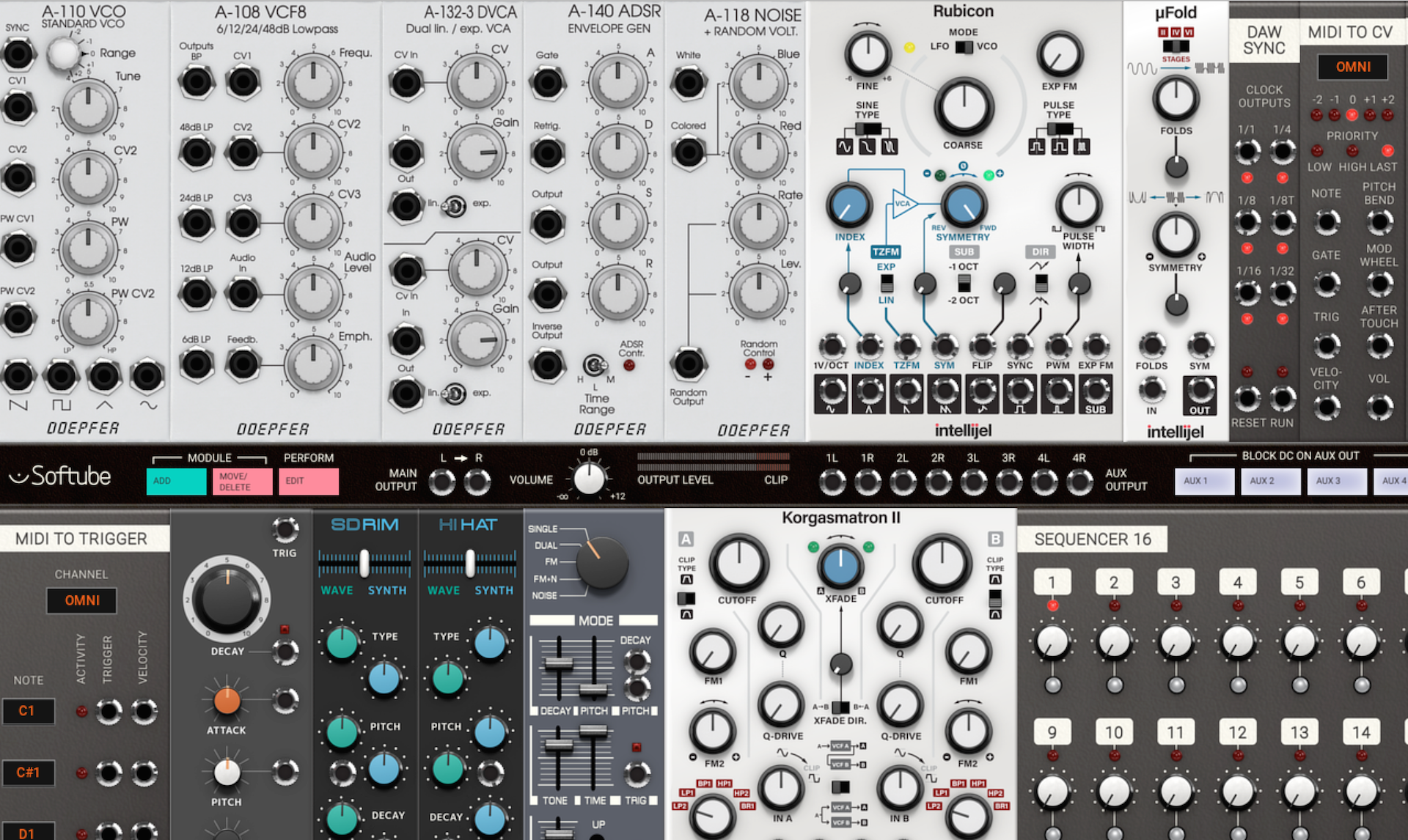XLR8R Review: Softube Modular
The hardware effects emulation kings make their first foray into the realm of virtual instruments

Since its launch in 2003, Swedish company Softube has become the undisputed king of hardware effects emulation. With glowing endorsements and partnerships from industry heavyweights as diverse as Marshall, Tube Tech, and Abbey Road Studios, as well as third party contracts with Ableton, Native Instruments, and Propellerheads among others, Softtube has become the bar against which all other hardware emulations are measured. Indeed, with the exception of perhaps Universal Audio with their UAD powered plugins, there is no company on the market providing more accurate software emulations of the most sought after preamps, EQs, compressors, and effects—peruse the countless Youtube videos comparing their work against the real deal for proof of this. As such, their first foray into the virtual instrument realm in the form of Modular is a tasty prospect.
Installation
Softube utilizes Pace Anti-Piracy‘s iLok software for copy protection and recently adopted Gobbler for product downloads and real-time updates. Installation involves creating a Gobbler account for downloading all relevant installers, and existing iLok users can link their iLok accounts to Gobbler. As someone with multiple iLok accounts, this took me several hours of hunting for ancient passwords and several Gobbler re-installs as there currently appears to be no obvious way of linking multiple iLok accounts to the same Gobbler account; however new users can simply download both the iLok license manager and Gobbler and proceed with installation fairly seamlessly. A single solution in which the iLok download manger was included in the bulk download of Softube installers would simplify this process greatly, however, and as someone with enough years in the industry to remember Pace’s sorted history of bugs and system specific issues, I can only hope Softube develops a more elegant solution for installation and license management going forward.
Patch Creation, Performance, and Connectivity
Upon launching Modular for the first time, younger software users will inevitably be surprised at the extremely long load time on even moderately powerful systems. Once the plugin has loaded, users are greeted with a large overview of available modules meticulously modeled after the classic Eurorack modular hardware format which has been steadily rising in popularity over the last few years. Modules are added to the rack by selecting them and then engaging the move/delete button to position them over the rack space, while a third button allows connections to “performance” specific modules to be edited. Connections between modules are made using a very clean point-to-point patching systems in which swinging, color-coded cables are connected and then conveniently disappear to avoid the typical spider web of cables associated with real hardware modular systems.
In the current age of multiple gesture touch screens and drag-and-drop everything, this three-tiered approach feels clunky and antiquated at best. That said, compartmentalizing the tasks of deciding which modules you wish to use, how they will be inter-connected, and what additional global performance controls the patch requires does adhere closely to the real world of modular hardware. Building effective, satisfying modular synthesis patches involves constantly switching virtual hats between engineer, sound designer, and performer. For inexperienced users, however, a floating help/info systems similar to those applied by competitors such as Reaktor, MAX/MSP, and Tassman would be of great benefit.
Sound Quality: Power with a Price
Softube has partnered with Doepfer and Intellijel for the initial module models, as well as providing individual components from their own Heartbeat drum synthesis software. A fairly vast library of patches using the standard DAW-based pre-set systems gives a good overview of sounds on offer.
Unsurprisingly, the quality of their emulations from a purely sound perspective leaves all other competitors in the dust. Having compared their emulations to both the real hardware and all other software modular programs worth their salt, I can say unequivocally that that Softube’s position as the industry leaders in hardware emulation is unmatched. Admittedly, fairly unscientific blind shootouts in my own studio against the real hardware left everyone in attendance quite literally bowled over by the near one-to-one realism they have once again managed to achieve.
That said, if you want to drive a Lamborghini, you inevitably have to pay for it. Polyphony in the modular realm is the Godhead, and as such, the first patch I tried to build myself was a four-voice synth utilizing the included Doepfer modules. The patch spiked my Ableton studio machine which handles upwards of 100 tracks of simultaneous 24/96 audio on a regular basis with ease up into the 80% CPU realm and near unplayability.
While some reviewers might be quick to accuse the program in the case as unusable, I lean much more firmly toward the idea that Softube is simply once again ahead of the curve. Computers become vastly more powerful with each new annual upgrade, and in this case, one can only hope the industry will catch up with Softube’s remarkably forward-thinking technological vision.
Conclusion
Softube has once again proved its acumen in being the absolute rulers of the roost in terms of hardware emulation. While there are still some growing pains to go through in terms of usability, interface, and CPU usage, past experience suggests that Softube will no doubt get things right, and silicon valley will eventually catch up with the hardware demands their futuristic visions require.
Should it continue to expand its partnerships with other Eurorack developers, even in its current state, at a cost of 99 euros/dollars Modular provides an unprecedented resource for hardware Eurorack buyers to test existing modules and prevent expensive buyer’s remorse, and an affordable entry into the near endless creative possibilities offered up by modular synthesis to new users. All criticism aside, I count myself as at least one happy user who is excited to watch how this most revolutionary of software platforms continues to grow in the coming years.
_____
Test version: 2.4.7
Test system: Duo core I7, 16GB RAM, Windows 10, Ableton Live
Price: $99/ €99

